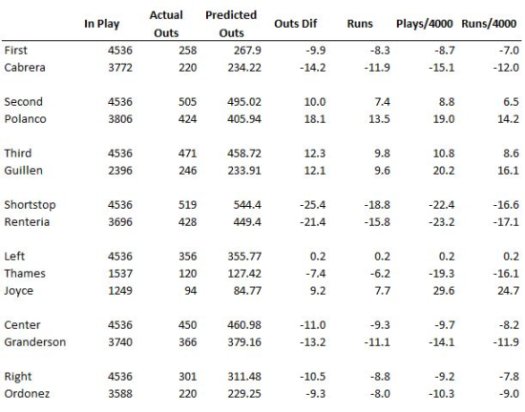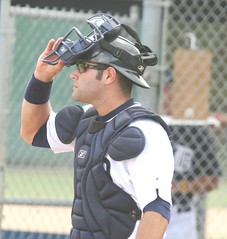With a disastrous season completed it is time to head into the offseason. Given the gravity of the collapse, you know with the high payroll and the last place-edness, there is probably a tendency to overreact and second-guess. While a deep dive analysis is definitely called for, there is also some inaccuracy being bandied about. With that in mind, some thoughts as we head into what will likely be a tumultuous winter.
Dave Dombrowski did not abandon his philosophy
I’ve heard this one frequently. The common thread is that Dombrowski abandoned his pitching first philosophy in favor of “buiding a slow pitch softball team.” Dombrowski has always believed in stock piling young pitching and using it as the building blocks of a team. Whether that entails using the pitchers on his own team, or trading it to fill needs, he’s always used young pitching.
The Renteria trade was made in large part for defense, not to build a slow pitch slugging softball team. The benefit of Renteria was that he was to be a 2 way player. The problem was that while Renteria was a defensive upgrade, it was a small upgrade (Guillen was -12 in 1074 innings at short in ’07, Renteria was -9 in 1173 innings in ’08 according to Fielding Bible +/-) and his offense was beyond absent the first half of the season. The trade failed, there’s no question, but it wasn’t a change of philosophy.
As for Cabrera, defense was never a part of the issue. It was entirely an offensive move. But it was also an opportunity that doesn’t come along that often. Players like Cabrera don’t grow on trees and to add an elite player at age 25 is largely unheard of. It is the kind of big splash move that Dombrowski has been known for throughout his career.
As for the rest of the staff, they were far worse than could have reasonably been expected. While Willis struggled last year and was trending down, to get nothing from him was unexpected to everyone. Robertson was never a top of the rotation starter, but was the epitome of a solid back of the rotation guy. To compete, along with Kenny Rogers, for worst starter in the league wasn’t part of any reasonable plan. And then there was Verlander adding a run and a half to his ERA. That your entire starting rotation would be injured or significantly underperforming wasn’t part of any plan or strategy and more than could have been mitigated.
The window isn’t closed
I should adjust that and say “the window isn’t closed if Ilitch doesn’t want it to be.” The boss could go all Huizenga and say “cut-cut-cut” but I don’t see that happening. This team was positioned to go for it in both 2008 and 2009. Because 08 was crap doesn’t mean you need to abandon 09 as well. The offense should be good again next year, and it isn’t unreasonable to think that the pitching staff will see some return to non-crapitude next year.
In terms of trading, they’d be selling low on most of the players that fans want to see traded. They could probably get a nice return for Armando Galarraga, Curtis Granderson, and Miguel Cabrera, but who really wants to see them shopped?
Don’t overreact
Everybody wants speed, defense, and starters, and bullpen arms. Some better defense would be nice, but don’t sacrifice offense completely. The Tigers are ready to make that move at third with the Inge pronouncement. It means they can’t afford to do it at both catcher and shortstop.
The bullpen was awful, but 5 years and $75 million to fix it will be money poorly spent. As for starters, is it worth a second round draft pick to sign a Derek Lowe type starter? (it might be if the Tigers can get the draft pick compensation for Renteria)
I’m not saying do nothing. Clearly this team has holes at multiple positions and another starter and a 2-3 new bullpen arms are clearly needed. But I still think, and perhaps this is naive, but good teams can have bad seasons. This team wasn’t as good as we thought going in, and it isn’t as bad as we think right now. I’ll borrow this conclusion from Nate Silver’s piece in Baseball Prospectus ($) and quote sparingly because it is premium content.
Bad years happen to good clubs. The key for the Tigers will simply be not to panic, nor to try and save face with guys like Renteria and Willis whose projections don’t really warrant it. The Tigers need to budget somewhere between $15-$20 million for perhaps three pitchers next year, but with the contracts of Renteria, Todd Jones, Kenny Rogers, and Ivan Rodriguez all coming off the books, they can easily afford to do so without increasing payroll.
…
This has been a frustrating season in Detroit, but hardly a disastrous one in terms of the club’s long-term fortunes. There have been several pleasant surprises this year in Galarraga, Joyce, and Brandon Inge’s smooth transition back to the catcher position*. From top to bottom, the Tigers still rank somewhere in the top ten in the major leagues in terms of their overall talent pool, and they should be on track to return to contention with some relatively common-sense fixes.
*The Inge part was written on August 14th before Inge completely collapsed down the stretch offensively and started allowing a PB per game.

